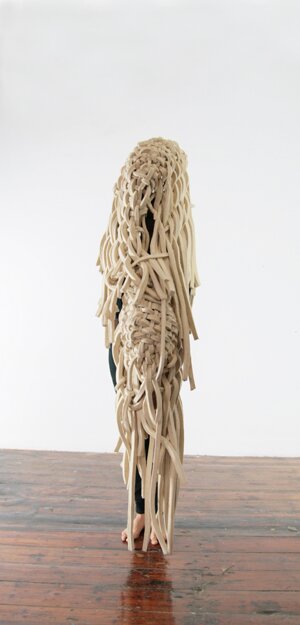In an event titled Mend the artist Kirsten Campbell showcased her recent work, on Wednesday the 3rd of April in Tatiana Kourochkina Art Gallery, Barcelona. Her sculptures stood charged and poised, and further enlivened in supporting stills, where each work becomes the mantle of the motion that drove it, enacted by Campbell.
The Minimalist Richard Serra wrote a list of verbs: ‘ to twist, to fold, to split, to bend, to repair’¹ etc., and with a simple application of these verbs to material suggested the notion that sculpture could be the residue of a particular activity. Campbell too applies a systematic tearing apart and weaving or mending back together, beginning purely with the material and her gut reaction to it. To look at her work verbs pour into your head, but narratives also begin to unfold from the work with such a very non-Minimalist aesthetic.
As much as material provided the impetus for Campbell’s process, their very tactility provokes rich association. In Flood, gushing from a death mask built of bird feathers, plaster and shell, strings of pearls fall in a visceral pouring of luxurious overload. The creamy beads spill down onto the floor from a height and the feminine dripping of pearls bring with it metaphors of birth and bodily function.
Death lurks unbidden in the husk of a presence through many works. Where in life it supported Campbell, in death, adorned and adored it supports what can be found in those moments of loss and regeneration. As she said of the time of finding her art process: ‘I had the strength of a pit-bull behind me’.
Pulled over a shadow, the dense, smothering, all absorbing grey felt of Pith, heavy in every way, woven and heaved together, becomes a mourning blanket, drenched in care and sorrow. Fey Fog descends in a shroud made of frail, stained and tired leaf skeletons, all sewn together. Between the monuments of birth and death lies the mundane and in the bothersome action of shaking out laundry Campbell finds a simple depth. Between heavy and light, stained and clean, the contrasts pushed into relief each sculpture’s beat.
In the aesthetics, actions and process there is something ritualistic, almost tribal about Campbell’s work. In the research of tribal art Herbert M. Cole studied the art of the tribal peoples of Iboland, Africa; they have their own art of masks, costumes and figurines, which lift ‘experience from the every day world, giving shape to those abstract truths that cannot otherwise be expressed’. It forms part of a complex of interactions and rituals crucial to the fabric of life in the tribe. But it is in the making and use of where that the art is assumed by them, rather than in the isolated objects. In other words their art is the process rather than the form. Cole argued that Ibo art should be understood as a verb; ‘hunting’ is not after all, heads on the wall².
Certainly Campbell has little connection with Iboland, but in this light her work; being so much about process, appears too as cogs of her world and its rituals. Every where the irreverence of caring for her little girls who so delight in cheap beads, dressing up, or collecting feathers at the zoo, dances in between. Campbell’s art process cannot pretend a separate life from that of her own, and it’s ‘residue’ is not beyond performance.
The event was perhaps a unique moment to experience a voluble engagement with chords of a life, rather than trophies on a wall or in a gallery space. It was a cacophony of verbs, not least ‘to mend’, and that’s what made it an event rather than an exhibition.
Find out more about Kirsten Campbell.
¹ Serra, Richard, The Original Work of Art: What it has to Teach, Yale University Art Gallery Bulletin, 2003, pp 26-39
² Cole, Herbert M., Art as a Verb in Iboland, African Arts, Vol. 3, No. 1, Autumn 1969, pp 34-41
- Share:
- Tweet
- Share on Tumblr





